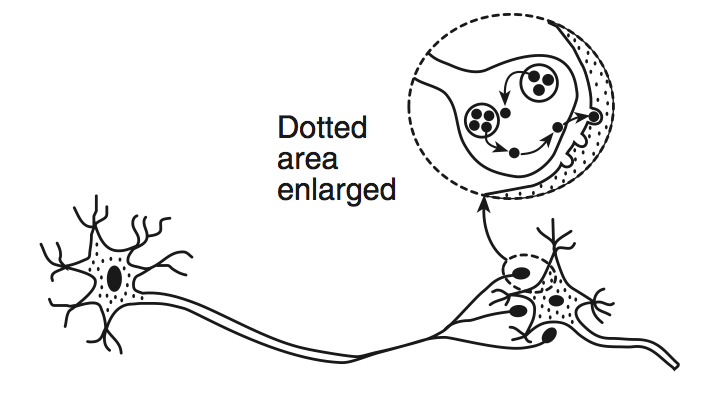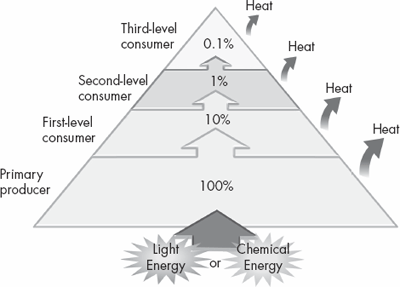The combination of all chemical reactions that occur in an organism is called:
a. diffusion
b. metabolism
c. reproduction
d. circulation
b. metabolism
Which is the correct order from least complex to most complex?
a. organelle-->tissue-->cell-->organ-->organ system
b. organ system-->cell-->tissue-->organelle-->organ
c. organelle-->cell-->tissue-->organ-->organ system
d. organ system-->organ-->tissue-->cell-->organelle
c. organelle-->cell-->tissue-->organ-->organ system
Mother rattlesnakes care for and protect their young. Baby rattlesnakes find safety in the coils of their mothers. Female snakes stay together for the first few weeks after giving birth. This gathering of female rattlesnakes provides a safe environment for newborn rattlers. This is an example of which type of adaptation?
a. structural
b. nutritional
c. molecular
d. behavioral
d. behavioral
Which organelle captures energy from the Sun and uses it to help produce organic molecules?
a. ribosomes
b. cytoplasm
c. vacuoles
d. chloroplasts
d. chloroplasts
What do proteins break down into?
a. amino acids
b. glucose
c. starch
d. nucleic acids
a. amino acids
Which observation could lead to the conclusion that an object is nonliving?
a. it passes on hereditary information only through asexual reproduction
b. it carries out synthesis
c. it cannot perform metabolic processes
d. it is composed of a cell, but does not have tissues
c. it cannot perform metabolic processes

A process that occurs in the human body is represented in the diagram. Which statement is most closely associated with the diagram?
a. small molecules are obtained from large molecules during digestion
b. certain molecules are replicated by means of a template
c. receptor molecules play an important role in communication between cells
d. energy from nutrients is utilized for waste disposal
c. receptor molecules play an important role in communication between cells
Certain animal species that are endangered or threatened have been cloned. Closely related species have been used to carry the embryos of the endangered species. This process of increasing the population size of a species in danger of becoming extinct is an example of a
a. natural method of decrease ecosystem stability
b. natural method of controlling the population of an endangered species
c. technological fix to increase habitat destruction
d. technological fix for the problem of endangered species
d. technological fix for the problem of endangered species
The genetic material of an organism is found in which organelle?
a. nucleus
b. cytoplasm
c. ribosome
d. vacuole
a. nucleus
Starches are macromolecules used for energy. Which monomer do starches break down into?
a. glucose
b. amino acids
c. lipids
d. starch
a. glucose
Provide 3 examples of the 7 characteristics of life
Organization: all living things are made of cells
Homeostasis: all organisms maintain a stable internal environment
Regulation: all organisms detect and respond to stimulus
Growth: all organisms show growth and development
Reproduction: all organisms reproduce
Metabolism: all organisms use energy
React: All organisms show adaptation to their environment
Which two organ systems provide materials required for the human body to produce ATP?
a. reproductive and excretory
b. digestive and respiratory
c. respiratory and immune
d. digestive and reproductive
b. digestive and respiratory
Decomposers are necessary in a food chain because they
a. manufacture food by photosynthesis
b. return nutrients to the ecosystem
c. absorb energy from the Sun
d. produce organic materials
b. return nutrients to the ecosystem
What does a ribosome do?
a. converts glucose to ATP
b. it contains all the cell's DNA
c. it constructs proteins from amino acids
d. it breaks down wastes for excretion
c. it uses instructions from DNA to synthesize protein
Which list is composed entirely of organic molecules?
a. water, DNA, and starches
b. water, proteins, and oxygen
c. proteins, DNA, and carbon dioxide
d. proteins, starches, and fats
d. proteins, starches, and fats, proteins, starches and fats
When the human body is responding to stress, the hormone adrenaline is released. A short time later, the body returns to normal. This is an example of how a human
a. reacts to an antibody
b. develops genetic variation in body cells
c. maintains cellular organization
d. maintains dynamic equilibrium
d. maintains dynamic equilibrium
Which hormone lowers your blood sugar if it is too high?
a. progesterone
b. insulin
c. testosterone
d. adrenaline
b. insulin
 Explain why energy is lost traveling up the pyramid.
Explain why energy is lost traveling up the pyramid.
energy is lost as heat through metabolic processes
Producers are organisms that make their own food (e.g. plants).
When you put a cell in a salt solution, it shrinks because
a. salt enters the cell
b. salt leaves the cell
c. water enters the cell
d. water leaves the cell
d. water leaves the cell
Which statement best describes some protein molecules in a cell?
a. proteins are long folded chains that can form various cell parts
b. proteins are composed of four different starches that direct cell activity
c. proteins are long, twisted strands of glucose that regulate cells.
d. proteins are genetically diverse substances that are synthesized in the nucleus.
a. proteins are long folded chains that can form various cell parts
Living organisms can best be distinguished from nonliving things by determining the presence or absence of
a. carbon atoms
b. oxygen atoms
c. metabolic activities
d. chemical reactions
c. metabolic activities
Explain how the circulatory system interacts with the respiratory system in a human.
Your answer MUST HAVE the following vocabulary: diffuse/diffusion, carbon dioxide, oxygen
Oxygen diffuses through the lung tissue (alveoli) into the bloodstream where it travels through the blood to the rest of the body. CO2 diffuses out of the cell and into the lung tissue and breathed out through exhalation.
Carbon dioxide and oxygen are important resources in ecosystems and are:
a. recycled through the activity of living systems
b. stored in the animals of the ecosystem
c. lost due to the activities of decomposers
d. released by the process of photosynthesis
a. recycled through the activity of living systems
Chloroplasts are the site of which chemical reaction and where are they found (what type of cell)?
photosynthesis
ONLY PLANT CELLS
Enzymes are produced as a direct result of which process?
a. protein synthesis
b. photosynthesis
c. respiration
d. enzymatic hydrolysis
a. protein synthesis